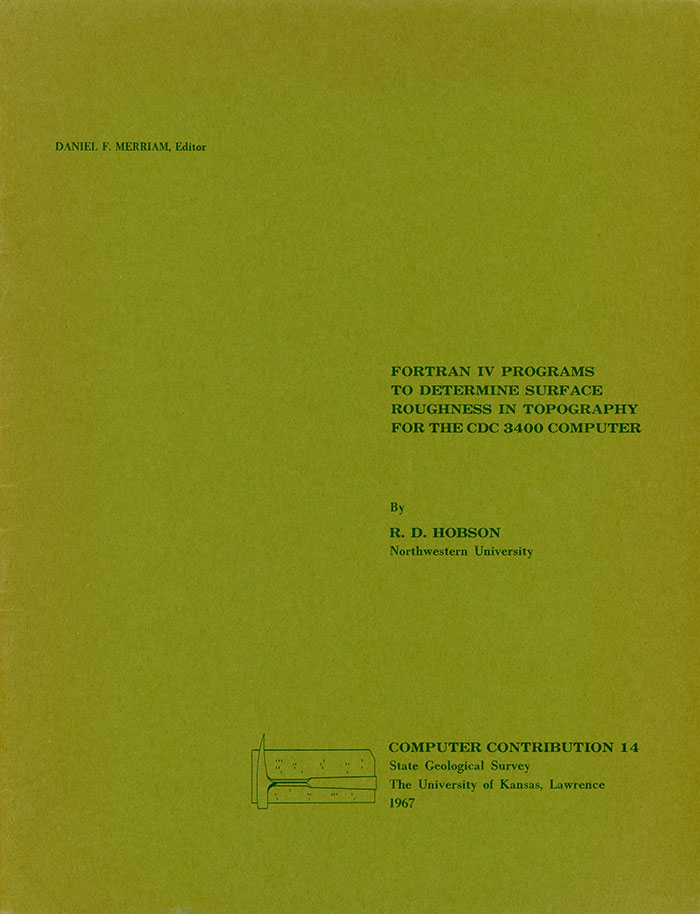
Kansas Geological Survey, Computer Contributions 14, originally published in 1967
Northwestern University

Originally published in 1967 as Kansas Geological Survey Computer Contributions 14.
Current uses of remote sensing apparatus for geologic investigation place new demands upon types of information gathered by the field geologist. One new area of field investigation is surface roughness.
This paper presents several quantitative parameters for describing three aspects of surface roughness: (1) comparison of surface areas, (2) frequency distribution of surface irregularities, and (3) orientation of normals to surfaces. Mathematical methodologies for computing parameters are described. Three CDC 3400 FORTRAN IV programs for computing parameters are listed along with detailed operating instructions.
Data obtained from the NASA Pisgah Crater Test Site in California are used to illustrate typical uses of surface roughness parameters.
Earth sensing and "ground truth" studies require certain types of geologic information which heretofore have been of little importance to the field geologist. For example, a map showing some characteristic (perhaps vegetation density or moisture content) of loose overburden covering an area may be of more importance to a sensing experiment than a classical geologic map showing distribution of rock types beneath that overburden. Experimentation with sensing apparatus indicates that certain factors, such as moisture content and specific gravity, strongly affect the sensed image of any particular test area. Another of these factors is surface roughness of topography (Dellwig and Moore, 1966).
A single concise definition of surface roughness probably is impossible. The only usable definitions are incomplete because they describe only a few of the physical or mathematical properties of a surface. There may be as many of these definitions as there are roughness studies themselves.
In the realm of earth sensing in which some type of electromagnetic wave form is directed upon an area, the surface roughness may be defined as a value on a scale ranging between equal ("smooth" surface) and random ("rough" surface) reflectance of those waves. On the other hand, terrain-analysis investigations may require roughness parameters describing larger scale irregularities of the surface than those affecting most remote sensing instruments.
It quickly becomes apparent that different types of investigations require particular sets of roughness parameters. For example, in Bechmann and Spizzichino's (1963) study of wave reflection, mathematical expressions of the surface are required. Kirchkoff approximations of the Rayleigh equations are used to generate these surfaces and then theoretical wave reflection patterns can be studied. It would be difficult to determine exact equations describing natural surfaces and thus other methods are necessary.
The current investigation is directed toward establishing roughness parameters that can be used to describe surface irregularities ranging from a few tenths of an inch to several tens of feet. For roughness parameters to be useful within this realm of terrain analysis, they must fulfill several basic requirements.
First, the parameters should be conceptually descriptive so that a value for any particular test area gives the investigator a mental image of the physical character of that area. The parameters should be easily measurable in the field so that large test sites can be quickly sampled. If possible, roughness parameters should be selected that require similar types of field measurements with a minimal amount of equipment. Parameters should be chosen which can be measured and compared at several different sampling scales and finally, they should be in a digital form suitable for numerical analysis.
The three terrain roughness parameters described in this investigation are: (1) comparison of estimated actual surface area with the corresponding planar area; (2) estimate of "bump," or elevation frequency distribution; and (3) comparison of the distribution and orientation of approximated planar surfaces within sampling domains. Three CDC 3400 FORTRAN IV computer programs for converting field measurements of these "megaroughness" features to standardized surface-roughness attributes are presented in the Appendices.
Read the PDF version (7.4 MB)
Kansas Geological Survey
Placed on web Aug. 28, 2019; originally published 1967.
Comments to webadmin@kgs.ku.edu
The URL for this page is http://www.kgs.ku.edu/Publications/Bulletins/CC/14/index.html